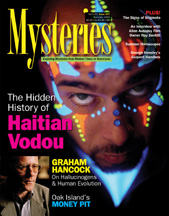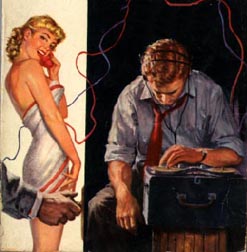-
ABANDON HOPE ALL YE WHO ENTER DEPARTMENT -
Tutankhamen-Like Curse Killed Nepal's Royal
Family?

One of the most gripping tales to have captured the public's imagination is the legend of Tutankhamen's curse, the superstition that the mummy of Egypt's boy-king took its revenge on the violators of its tomb, causing the death of the British excavators who discovered the grave in 1923.
Though the tales petered out in the 80s, after the woman who was the last link to the expedition died, a similar myth has now sprung up in Nepal, still regarded as a mysterious land that opened up to the outside world only in 1950.
According to Nepal's tabloid press, a secret room in a temple in western Nepal wields similar power, and could be responsible for the massacre of Nepal's royal family in 2001 as well as the sudden death of a parliamentarian recently.
More than two centuries ago, the forefather of the present King Gyanendra, swooped down on Kathmandu valley from the tiny kingdom of Gorkha in western Nepal and began annexing the neighbouring principalities.
The old palace still stands in Gorkha, protected by the temple of Gorkhakali, the goddess of war and power.
Like many old temples in Nepal, the Gorkhakali shrine has a 'vayu kotha' - a secret room said to contain dangerous powers and kept locked.
Though worshipers are forbidden to enter the secret room, the late queen, Aishwarya, ordered the lock to be forced open and entered it in May 2001, the Jana Aastha tabloid reported.
A week later, the queen, while attending a dinner party with family members, was gunned down along with king Birendra, three of their children, and other relatives, reportedly by her eldest son crown prince Dipendra who also perished in the infamous midnight massacre.
The scared temple authorities boarded up the room once again only to be commanded to re-open it last month, which was once again followed by death, the tabloid said.
Last month, a team of parliamentarians went to Gorkha as part of its mandate to visit Nepalese prisons and advise the government how to improve them.
The tabloid said that the head of the team, Dilli Raj Sharma, went to the temple where the priest told him about queen Aishwarya's visit.
An intrigued Sharma then reportedly asked the priest to have the door of the secret room forced open once again so that he could go inside.
By evening, Sharma, who had reportedly told his peers that he was in the best of health, had a sudden heart attack and died while he was being rushed to hospital.
'A coincidence connects the queen and the legislator,' the Nepalese tabloid said.
Scores of chilling legends, especially about the royal family, abound in Nepal.
The most repeated one is about how Prithvi Narayan Shah, the warrior king who had begun expanding his kingdom from Gorkha, angered a holy man with supernatural powers, Gorakhnath.
The sage cursed Shah, saying his dynasty would end after the 10th king.
Birendra, who died in the June 1, 2001 assassination along with his entire family, was the 10th king of the Shah dynasty.
Source: News Post India
http://newspostindia.com/report-10608
-
THE GENIUS YOU NEVER HEARD OF DEPARTMENT -
Scientist Gets a Hand With Inventing a Legacy
Scientist Gets a Hand With Inventing a Legacy

Elmer R. Gates was the most brilliant scientist you've never heard of. He taught dogs to see color. He studied the way emotions affect human breath. He had 43 patents to his name. He spent each waking moment intensely studying his own consciousness, going so deep inside himself that he was certain he had changed the very structure of his brain.
And he did it all in Chevy Chase in what at the time -- 1896 to 1908 -- was said to be the largest private laboratory in the United States. Yet today, even the folks at the Chevy Chase Historical Society haven't heard of this idiosyncratic genius.
Since 1904, Family and Child Services of Washington, D.C., Inc. has provided opportunities for less fortunate children to attend summer camp. Many of the children come from the city's foster care caseload. None of them could afford a week at camp without this support.
Idiosyncratic genius or crackpot?
That's the problem. Some of Gates's theories were so outlandish at the time -- exercising the brain as if it were a muscle? -- that he was embraced, if he was embraced at all, by the fringiest of knowledge-seekers.
Lee Humphries of Minneapolis wants to change that. Last year Lee, 65, launched http://www.elmergates.com, a Web site devoted to all things Elmer.
Gates seems to have been more concerned with how something was invented than what was invented. He was convinced that people could put themselves in the right frame of mind to be creative, possibly by adjusting their physical surroundings. And so he paid special attention to the conditions when he was most creative.
Said Lee: "He kept voluminous records on his own physiology, taking urine samples several times a day and blood samples. He would take his temperature. He was doing this to find out what his physiological state was when he was most productive."
Sometimes Gates would do his thinking in a special chamber in which he could regulate the temperature, humidity and electrostatic charge of the air. All to discover how external forces affected his thinking.
Except he didn't call it his "thinking," preferring the expression "mentative process" or "psychurgy."
Although he lectured at the Smithsonian and his lab played host to esteemed visitors, it was a mention in the book "Think and Grow Rich," by power-of-positive-thinking huckster Napoleon Hill that kept Gates's name alive.
That's where Lee, then a curious high-school student, first encountered him.
"I'm interested in creativity," Lee said. "I felt in my own meager way I had replicated some of [Gates's] results, essentially using the same introspective procedures for problem solving that he used."
Lee tracked down Gates's heirs and gained access to original papers, which he put up on his Web site. Gates "thought that ultimately he would synthesize all of this stuff and he would write his great work," Lee said.
Except he never did. He was in the fine tradition as such iconoclastic -- and doomed -- American inventors as Philo T. Farnsworth. Gates didn't publish, and he spread himself awfully thin. His dozens of inventions include ore separators, an electric iron and an early chemical fire extinguisher.
Since 1904, Family and Child Services of Washington, D.C., Inc. has provided opportunities for less fortunate children to attend summer camp. Many of the children come from the city's foster care caseload. None of them could afford a week at camp without this support.
He trained dogs to walk down a darkened hallway where tiles of certain colors were electrified, in the process becoming perhaps the first researcher to use negative reinforcement.
He had people in various emotional states breathe into a glass tube, collected the condensate, treated it with various agents and examined the precipitate. Newspapers at the time announced that Gates had declared that the color of sin was pink, one of many misinterpretations of his work, Lee said. In fact, Gates had discovered that a person's emotional state could affect his or her body's chemistry, something we take for granted now.
My favorite Gates invention is from 1903: Patent No. 741,903, "Educational Toy or Game Apparatus." It was a box whose lid had different shapes cut into it -- circles, triangles, squares -- and an assortment of similarly shaped blocks to go into it.
Elmer R. Gates invented the square peg for the square hole, the round peg for the round hole.
None of his inventions made him rich, though. He was too busy plowing money back into his lab, which he eventually lost. The pages of his diary from the spring of 1911 show an increasingly desperate man. Money had dried up, and Gates's journal alternates between desperation and inspiration. "My idea for artificial wrapping for sausages and bologna has leaked out," he laments. "I saw these goods for sale in the market recently!"
Then later: "10,000,000 dollars can be made on a non-magnetizable watch."
He decided to try to invent one. If he had, maybe you'd have heard of him.
Source: The Washington Post
http://www.washingtonpost.com/wp-dyn/content/article/2007/07/29/
AR2007072901267.html?referrer=emailarticle
-
UNLICENCED INCARNATES
FACE STIFF FINE DEPARTMENT -
China Tells Living Buddhas to Obtain Permission Before They Reincarnate
China Tells Living Buddhas to Obtain Permission Before They Reincarnate

Tibet’s living Buddhas have been banned from reincarnation without permission from China’s atheist leaders. The ban is included in new rules intended to assert Beijing’s authority over Tibet’s restive and deeply Buddhist people.
“The so-called reincarnated living Buddha without government approval is illegal and invalid,” according to the order, which comes into effect on September 1.
The 14-part regulation issued by the State Administration for Religious Affairs is aimed at limiting the influence of Tibet’s exiled god-king, the Dalai Lama, and at preventing the re-incarnation of the 72-year-old monk without approval from Beijing.
It is the latest in a series of measures by the Communist authorities to tighten their grip over Tibet. Reincarnate lamas, known as tulkus, often lead religious communities and oversee the training of monks, giving them enormous influence over religious life in the Himalayan region. Anyone outside China is banned from taking part in the process of seeking and recognising a living Buddha, effectively excluding the Dalai Lama, who traditionally can play an important role in giving recognition to candidate reincarnates.
For the first time China has given the Government the power to ensure that no new living Buddha can be identified, sounding a possible death knell to a mystical system that dates back at least as far as the 12th century.
China already insists that only the Government can approve the appointments of Tibet’s two most important monks, the Dalai Lama and the Panchen Lama. The Dalai Lama’s announcement in May 1995 that a search inside Tibet — and with the co- operation of a prominent abbot — had identified the 11th reincarnation of the Panchen Lama, who died in 1989, enraged Beijing. That prompted the Communist authorities to restart the search and to send a senior Politburo member to Lhasa to oversee the final choice. This resulted in top Communist officials presiding over a ceremony at the main Jokhang temple in Lhasa in which names of three boys inscribed on ivory sticks were placed inside a golden urn and a lot was then drawn to find the true reincarnation.
The boy chosen by the Dalai Lama has disappeared. The abbot who worked with the Dalai Lama was jailed and has since vanished. Several sets of rules on seeking out “soul boys” were promulgated in 1995, but were effectively in abeyance and hundreds of living Buddhas are now believed to live inside and outside China.
All Tibetans believe in reincarnation, but only the holiest or most outstanding individuals are believed to be recognisable — a tulku, or apparent body. One Tibetan monk told The Times: “In the past there was no such regulation. The management of living Buddhas is becoming more strict.”
The search for a reincarnation is a mystical process involving clues left by the deceased and visions among leading monks on where to look. The current Dalai Lama, the fourteenth of the line, was identified in 1937 when monks came to his village.
China has long insisted that it must have the final say over the appointment of the most senior lamas. Tibet experts said that the new regulations may also be aimed at limiting the influence of new lamas.
Source: China View
http://chinaview.wordpress.com/2007/08/06/china-tells-living-buddhas-to-obtain-permission
-before-they-reincarnate/







